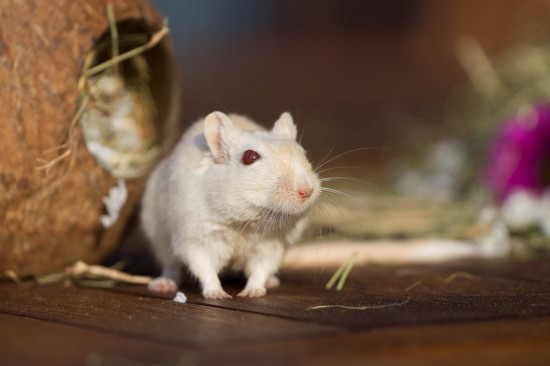

Gerbils are interesting pets to watch, many gerbil owners can let the hours pass away watching them move around their cage. Generally speaking they interact with each other and us in a curious and sometimes playful manor.
We can often get stuck wondering exactly why gerbils are doing some specific things, and what certain behaviours mean. In this article we cover a breakdown of the more common behavioural traits and habits of gerbils.
Gerbils spend a fair amount of time grooming and keeping their coats in good condition. Like a lot of other small animals they use their tongue and paws to comb through the fur all over their bodies. Seeing a well groomed gerbil is a sign that it is happy and healthy, if you notice your gerbil becoming scruffy and unkempt there is an underlining issue to look into.
In a grooming method not too dissimilar to chinchillas, if you provide some sand in a dish most gerbils will use it as a method of cleaning their fur. They won’t bath in it like chinchillas, but they will definitely use it as a grooming aid. This is something they would use in the wild, it is not a necessity for you provide.
Gerbils like to have company, so having more than one gerbil in the cage is a great idea to keep them happy. Although there might be some tension and fighting from time-to-time, you will notice that gerbils can be affectionate to one another. It’s a wonderful sight to see, it’s reassuring that there is a good balance in their colony.
When sleeping or laying down in nests gerbils will huddle together to keep each other warm. Often grooming and licking each other, this shows that they are happy and living together in harmony. If you have a litter of pups you may notice members of the community helping out and cleaning the newborns.
Gerbils will form different relationships with one another in their colony. Some gerbils are more aggressive than others, while some are very social and friendly. It is not uncommon for gerbils that live together to have brief scuffles, there is not always damage inflicted and it is usually over in a matter of seconds. When introducing a new gerbil it can be a completely different situation, aggressive behaviour towards new gerbils is a lot more severe.
Relationships between pups will be competitive as they grow up. Pups are always looking to prove themselves and establish themselves within the colony as the strongest. They will often fight over food and challenge each other, but it’s usually nothing more than a brief showing of authority.
Any gerbil owner will have seen their gerbil thumping the ground with their hind legs. This is widely used in the wild to warn other gerbils of impending danger, or to alert others to something the thumping gerbil has become aware of. In a cage they use this as a way to draw attention to something.
Young gerbils will make this thumping sound for seemingly no reason at times, it is thought that they are merely practicing, getting used to thumping in case it’s needed. Adults on the other hand will make some thumping motions when sexual activity is taking place and they are excited. For either reason, it is advised you do not interfere with gerbils when they are thumping the ground.
Gerbils are very quiet animals and will not often use noise to communicate with you. They can make a high pitched sound when fighting, and sometimes young pups will make a similar noise as they discover it for themselves. But apart from this don’t expect to hear much out of them.
Gerbils need to gnaw on things to keep their teeth trimmed, much like other rodents. They will gnaw daily and you will have to provide suitable items for them to use. Otherwise they will start gnawing through anything and everything they can get their teeth round.
Blocks of wood, mineral blocks or cardboard are suitable materials for them to use. After some trial and error you may want to settle on the quietest option, hearing gerbils gnaw on things can become a very monotonous noise over time. If you do not think your gerbil is gnawing enough, take a close look at their teeth to see if there are any problems.
Gerbils have powerful hind legs and are very adept at jumping. From a young age pups can jump very well and will become familiar with jumping around their cages over obstacles. If you place food high up or in different areas in their cage behind obstacles, you will notice they can get to it by jumping if need be.
Fully grown gerbils can jump around 30cm high when required. When placed in small spaces or if they feel trapped they will usually use their jumping ability to escape. Outside of necessary reasons they will rarely jump, it is not the case that you will see them jumping around their cage just for fun.
In the wild gerbils will burrow wherever they find suitable ground to do so when searching for food, or making a home. On closer inspection you will notice that gerbils have very sharp claws, these are designed to burrow through a range of different surfaces. If you watch them burrowing in their cage you will see the speed with which they operate, it’s impressive to watch and allows them to hide quickly underground if needed.
There are some plastic cages that try to replicate the burrowing nature of many rodents. They have tunnels attached that lead off in different directions and usually loop back round to the cage. These are fun, but there is nothing quite like the real thing. If you have a large enough cage, provide a deep layer of shavings and watch as your gerbils burrow as deep down as they can go.
Copyright © 2005-2016 Pet Information All Rights Reserved
Contact us: www162date@outlook.com